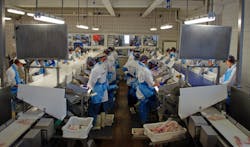Hyperspectral imaging checks cod for quality
A PhD student from the University of Tromsø in Norway has developed a hyperspectral imaging system that can automatically inspect cod fillets.
Manual trimming and inspection of cod fillets is currently regarded as the most time-consuming and expensive aspect of fillet production in Norway, accounting for nearly 50% of the production cost.
Most aspects of fish processing in Norway are mechanized. But inspection and trimming is still manual, and often creates a bottleneck in the production line. Nematodes are regarded as the most important element in a fillet to detect, but also the most difficult.
The new system -- developed by PhD student Agnar Sivertsen -- illuminates the cod fillet with the skin on or off, after which hyperspectral images are captured of the fish. By analyzing the hyperspectral data, the system can then automatically detect the nematodes as well as where in the fillet they are located.
In addition to detecting unwanted elements in the fillets, the system can provide information about how fresh the fish is by determining how long it has been on ice and if it has been frozen.
The system can inspect the cod at a rate of one fillet per second.
-- By Dave Wilson, Senior Editor, Vision Systems Design
